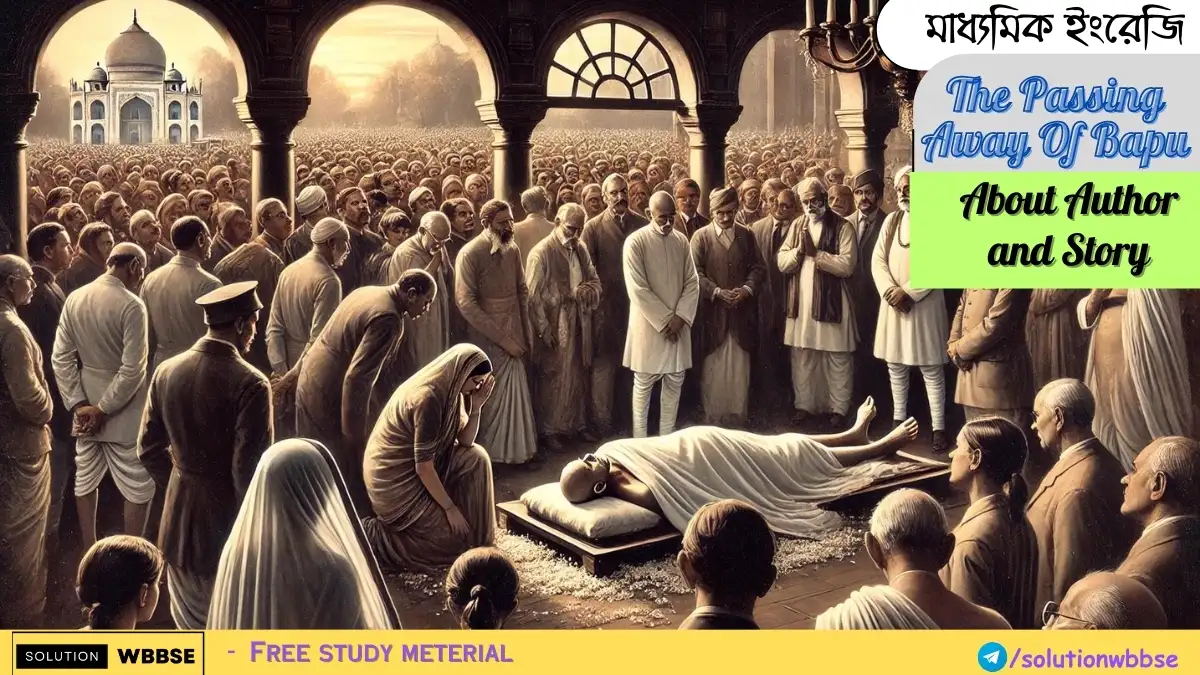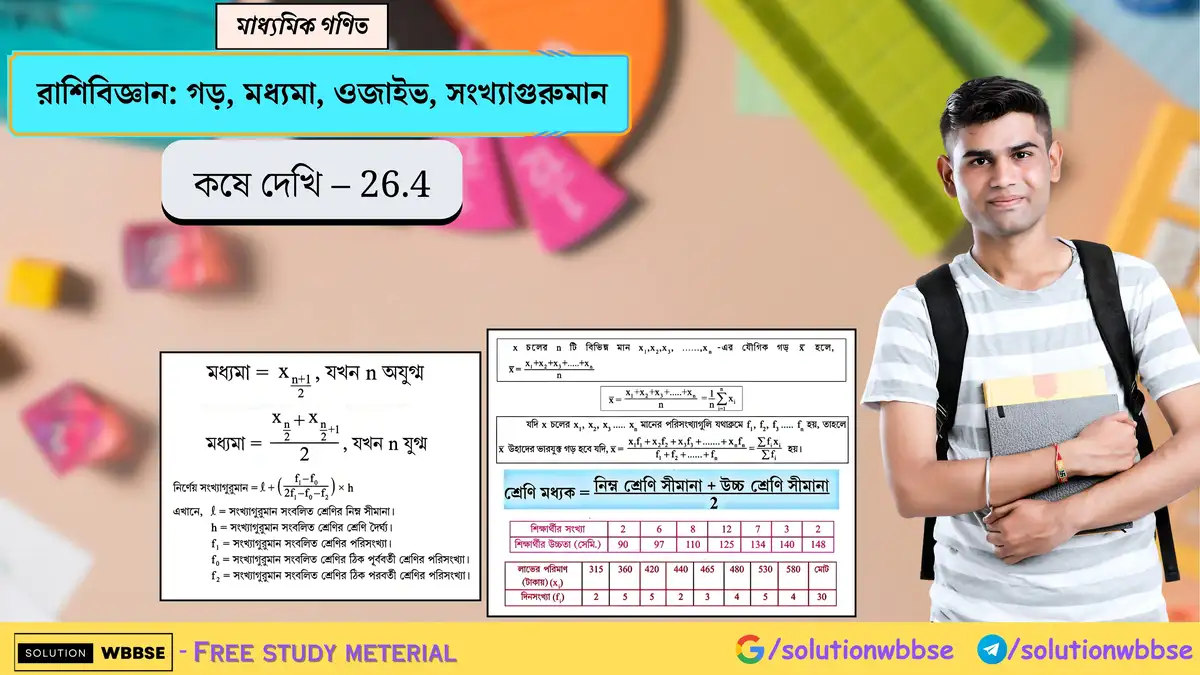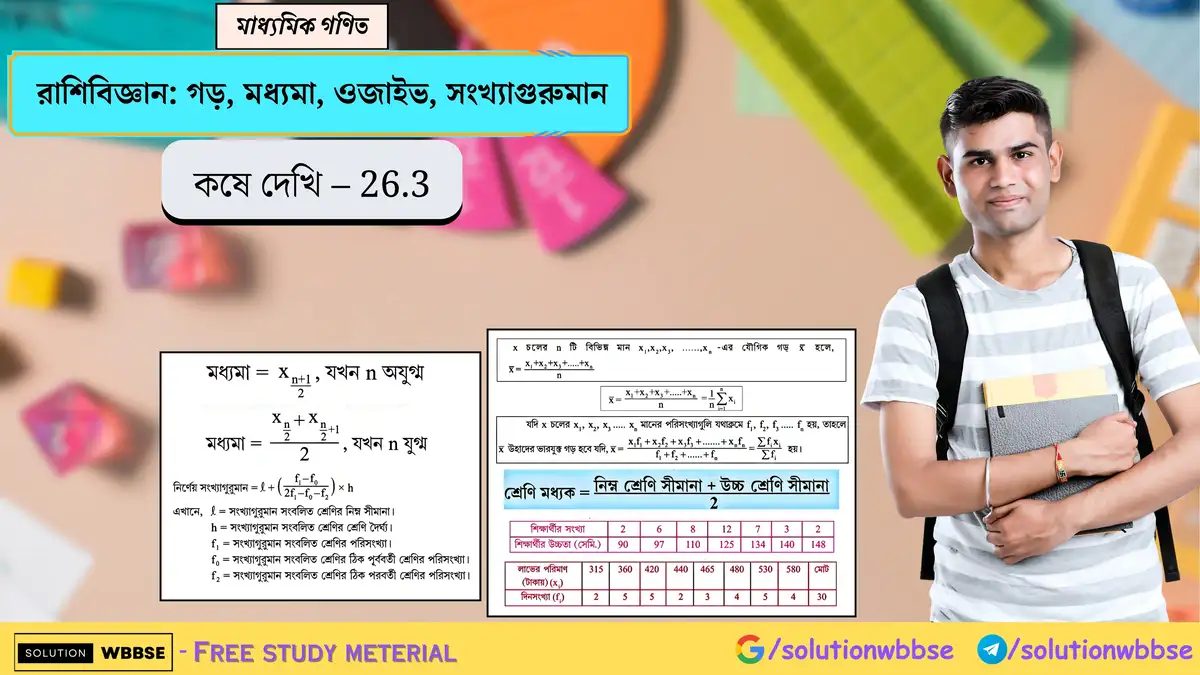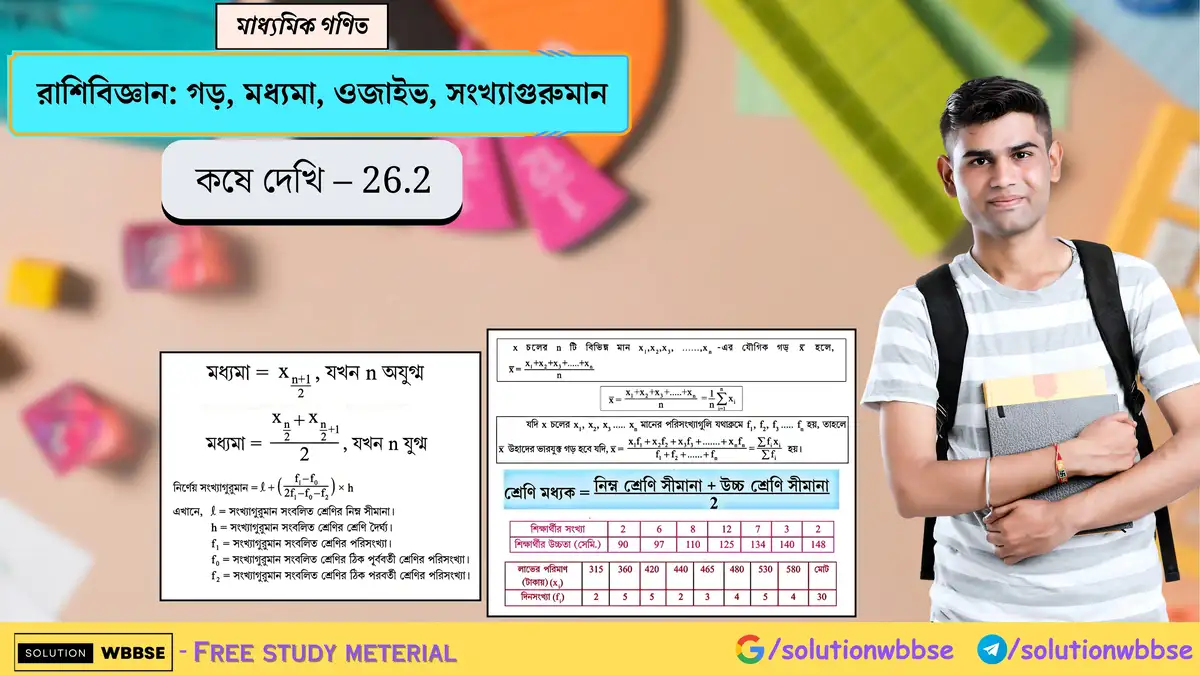আজকে আমরা আমাদের আর্টিকেলে মাধ্যমিক ইংরেজির তৃতীয় অধ্যায় “The Passing Away of Bapu” এর লেখক পরিচিতি এবং গল্পের সংক্ষিপ্ত রূপ নিয়ে আলোচনা করবো। এই বিষয়টি “The Passing Away of Bapu” গল্পটি বোঝার জন্য অত্যন্ত গুরুত্বপূর্ণ। কারণ এই অংশের প্রশ্নগুলি মাধ্যমিক পরীক্ষায় প্রায়ই দেখা যায়। আশা করি যে এই আর্টিকেলটি আপনাদের জন্য উপকারী হবে।

About the Author
Nayantara Sehgal was born on May 10, 1927, into one of India’s most prominent political families. Her mother, Vijayalakshmi Pandit, was India’s first ambassador to the USSR. Later she became the first woman President of the United Nations General Assembly. Her uncle, Jawaharlal Nehru, was India’s first Prime Minister, and her first cousin, Indira Gandhi, was India’s third Prime Minister. So it is not surprising that politics and history inspire and underlie much of her writing. Beginning with her memoir ‘Prison and Chocolate Cake,’ which was published in 1954, Sehgal has authored many political writings like ‘The Story of India’s Freedom Movement’ and ‘Indira Gandhi: Her Road to Power,’ along with a number of collections of essays, such as ‘Point of View: A Personal Response to Life, Literature, and Politics,’ etc.
Novels bring out Nayantara Sehgal as a writer with feminist concerns seeking the independent existence of women. She sees women as victims of traditional Indian society engaged in their quest for identity.
She received the Sinclair Prize (Britain) for fiction in 1985, the Sahitya Akademi Award in 1986, and the Commonwealth Writers’ Award (Eurasia) in 1987. She was also a Fellow at the Woodrow Wilson International Centre for Scholars, Washington, from 1981 to 1982.
As ‘the child of Gandhi’s India,’ her own life, both literary and personal, presents her as a great champion of Gandhian approaches and ideologies in life. Her novels, including her autobiographies, clearly bring forth the influence of Gandhian principles and thoughts on her.
লেখক পরিচিতি
ভারতবর্ষের সবচেয়ে উজ্জ্বল রাজনৈতিক পরিবারগুলির মধ্যে একটিতে ১৯২৭ সালের ১০ মে নয়নতারা সায়গল জন্মগ্রহণ করেন। তাঁর মা বিজয়লক্ষ্মী পণ্ডিত ছিলেন সোভিয়েত রাশিয়ায় নিযুক্ত ভারতবর্ষের প্রথম রাষ্ট্রদূত। পরবর্তীকালে তিনি রাষ্ট্রপুঞ্জের সাধারণ সভায় প্রথম মহিলা সভাপতি নির্বাচিত হন। তাঁর কাকা জওহরলাল নেহরু ছিলেন ভারতবর্ষের প্রথম প্রধানমন্ত্রী এবং তাঁর খুড়তুতো দিদি ইন্দিরা গান্ধী ছিলেন ভারতবর্ষের তৃতীয় প্রধানমন্ত্রী। তাই এটি মোটেই আশ্চর্যের বিষয় নয় যে তাঁর বেশিরভাগ লেখার অনুপ্রেরণা ও ভিত্তিস্বরূপ হবে রাজনীতি ও ইতিহাস। ১৯৫৪ সালে প্রকাশিত স্মৃতিকথা ‘প্রিজন অ্যান্ড চকোলেট কেক’ দিয়ে শুরু করে সায়গল বহু রাজনৈতিক লেখা লিখেছেন, যেমন – ‘দ্য স্টোরি অব ইন্ডিয়াস ফ্রিডম মুভমেন্ট’ আর ‘ইন্দিরা গান্ধী: হার রোড টু পাওয়ার,’ সেইসঙ্গে একাধিক প্রবন্ধ সংকলন, ‘পয়েন্ট অব ভিউ: আ পার্সোনাল রেসপন্স টু লাইফ, লিটারেচার অ্যান্ড পলিটিক্স’ ইত্যাদি।
উপন্যাসগুলি লেখিকা নয়নতারা সায়গলের নারীবাদী সত্তার রূপ তুলে ধরে যা মেয়েদের স্বতন্ত্র অস্তিত্বের পক্ষে। তিনি মেয়েদের দেখেন চিরাচরিত ভারতীয় সমাজের বলি হিসেবে, যারা নিজেদের অস্তিত্বের খোঁজ করে চলেছে।
তিনি ১৯৮৫ সালে উপন্যাসের জন্য সিনক্লেয়ার পুরস্কার পান, ১৯৮৬ সালে সাহিত্য অকাদেমি পুরস্কার এবং ১৯৮৭ সালে কমনওয়েলথ রাইটার্স অ্যাওয়ার্ড (ইউরেশিয়া) পান। উড্রো উইলসন ইন্টারন্যাশনাল সেন্টার ফর স্কলারস, যেটি ওয়াশিংটনে অবস্থিত, সেখানে ১৯৮১ থেকে ১৯৮২ পর্যন্ত তিনি ফেলোও ছিলেন।
‘গান্ধির ভারতের সন্তান’ হিসেবে তাঁর ব্যক্তিজীবন ও সাহিত্যজীবন তাঁকে গান্ধীবাদী দৃষ্টিভঙ্গি ও মতাদর্শের এক মহান প্রবক্তারূপে উপস্থাপিত করে। তাঁর আত্মজীবনী-সহ উপন্যাসগুলি তাঁর ওপর গান্ধীবাদী নীতি ও চিন্তাভাবনার প্রভাবের সুস্পষ্ট প্রকাশ ঘটায়।
Summary and Critical Perspective of the Essay
The given text is an excerpt from Nayantara Sehgal’s autobiography. It shows the degree of emptiness created by the sudden death of Gandhiji. People all over the country were shocked by the incident. Initial silence followed by wild crying at the Birla House showed the effect of an unexpected loss. Gandhiji’s funeral took place the day after his death. Hours in advance, people lined the route of the procession. The narrator also walked with other people. It was almost impossible to move in the thick crowd. While walking, she felt how walking with Bapu carried a different meaning. Bapu’s ashes were immersed in the Ganges in Allahabad. Back in Delhi, the narrator primarily felt at a loss. But gradually, she came out of the phase and felt proud to bear the banner of Bapu. The narrator understood that Bapu’s India would live in his children.
প্রবন্ধটির সারসংক্ষেপ এবং রসগ্রাহী আলোচনা
নয়নতারা সায়গলের আত্মজীবনীর সংক্ষিপ্ত অংশ এই পাঠ্যাংশটি। এটি ব্যক্ত করে সেই অসীম শূন্যতা যা সৃষ্টি হয়েছিল গান্ধিজির হঠাৎ প্রয়াণে। এই ঘটনায় গোটা দেশের মানুষ মর্মাহত হয়েছিল। বিড়লা হাউসের প্রাথমিক নীরবতা ও পরে বাঁধভাঙা কান্না এই অপ্রত্যাশিত ক্ষতির প্রতিফলন ঘটাচ্ছিল। গান্ধিজির মৃত্যুর একদিন পর তাঁর অন্ত্যেষ্টিক্রিয়া সম্পন্ন হয়েছিল। সেই যাত্রা আরম্ভের বহু আগে থেকেই মানুষ রাস্তায় ভিড় করে দাঁড়িয়েছিল। কথকও অন্য সবার সঙ্গে হেঁটেছিলেন। সেই প্রচণ্ড ভিড়ে হাঁটা প্রায় অসম্ভব হয়ে উঠেছিল। হাঁটার সময় তিনি অনুভব করেছিলেন যে বাপুর সঙ্গে হাঁটা একটা অন্য অর্থ বহন করে। বাপুর ভষ্মাবশেষ এলাহাবাদের গঙ্গায় নিমজ্জিত করা হয়েছিল। দিল্লিতে ফিরে এসে কথক প্রাথমিকভাবে এক শূন্যতা অনুভব করেছিলেন। কিন্তু ধীরে ধীরে তিনি সেই পরিস্থিতি থেকে বেরিয়ে এলেন এবং বাপুর ভাবাদর্শ বহন করার জন্য গর্ব অনুভব করলেন। কথক বুঝতে পারলেন বাপুর ভারতবর্ষ তাঁর সন্তানদের মধ্যেই বেঁচে থাকবে।
Understanding the Text
Nayantara’s childhood and youth themselves have had a permanent mark of Gandhian ideology on them. It is noteworthy that she found an inspiring and motivating glimmer in the personality of Mahatma Gandhi, who led a life with full simplicity and high thinking.
Godse approached Gandhi on January 30, 1948, during the evening prayer at 5:17 PM. When Godse bowed, one of the girls supporting Gandhi, said to Godse, “Brother, Bapu is already late” and tried to put him off, but he pushed her aside and shot Gandhi in the chest three times with a semi-automatic pistol. Gandhi was taken to Birla House, but that was the end of the Nation’s Father. Following the assassination of Gandhi, Godse was put on trial at the Punjab High Court. On November 8, 1949, he was sentenced to death. Godse was hanged at Ambala Jail on November 15, 1949.
The last act Gandhiji did was to lift both his hands as a sign of prayer towards the large gathering which had assembled for the prayer. Thereafter, he was speechless, and the loss of blood at his age made death inevitable. Lord Mountbatten and Cabinet Ministers, including Pandit Jawaharlal Nehru, Sardar Vallabhbhai Patel, and Maulana Abul Kalam Azad, soon arrived.
Pandit Jawaharlal Nehru, who returned from Amritsar that afternoon, did not have an opportunity to meet Gandhiji. Pandit Nehru came out to address the huge gathering of nearly two lakhs which had surrounded Birla House. They broke down with grief more than once when he spoke. The leaders, including Pandit Nehru, were dazed and perplexed, while tears overflowed down the cheeks of countless women and men both inside and outside Birla House. The grief-struck crowd, which went on swelling in numbers, were making their way into the main building to have a last glimpse of the departed leader. The crowd restrained themselves, and leaders soon made arrangements to let the crowd see Mahatma Gandhi. The people of India felt insecure and helpless at large because they had lost the beacon called Gandhiji.
পাঠ্যাংশের প্রেক্ষিত
নয়নতারা সায়গলের শৈশব ও যৌবনেই গান্ধীবাদী আদর্শের স্থায়ী ছাপ ছিল। উল্লেখযোগ্য যে, তিনি মহাত্মা গান্ধির মধ্যে এক অনুপ্রেরণাকারী এবং উৎসাহব্যঞ্জক ব্যক্তিত্বের খোঁজ পেয়েছিলেন, যিনি চিরকাল সরল এবং উঁচু ভাবনার জীবন যাপন করেছেন।
১৯৪৮ সালের ৩০ জানুয়ারি, বিকেল ৫টা ১৭ মিনিটে, সান্ধ্য প্রার্থনার সময়, গডসে গান্ধিজির দিকে এগিয়ে গেলেন। গডসে যখন শ্রদ্ধায় মাথা নীচু করলেন, গান্ধিজিকে ধরে থাকা মেয়েদের মধ্যে একজন গডসেকে বললেন, “ভাই, বাপুর আজকে ইতিমধ্যেই দেরি হয়ে গেছে” এবং তাকে সরিয়ে দেওয়ার চেষ্টা করেন, কিন্তু গডসে তাকে ঠেলে সরিয়ে দেন এবং একটি আধা-স্বয়ংক্রিয় পিস্তল থেকে গান্ধিজির বুকে পরপর তিনটি গুলি করেন। গান্ধিকে বিড়লা হাউসে নিয়ে যাওয়া হয় কিন্তু সেখানেই জাতির জনকের সব শেষ হয়ে যায়। গান্ধি হত্যার পরে, পাঞ্জাব হাইকোর্টে গডসের বিচার হয়। ১৯৪৯ সালের ৮ই নভেম্বর তাকে মৃত্যুদণ্ডে দণ্ডিত করা হয়। ১৯৪৯ সালের ১৫ই নভেম্বর আম্বালা জেলে তাকে ফাঁসি দেওয়া হয়।
গান্ধিজি যে শেষ কাজটি করেছিলেন সেটি হল প্রার্থনার জন্য জমায়েত হওয়া অসংখ্য মানুষের দিকে প্রার্থনার ভঙ্গিতে দু-হাত জড়ো করে মাথার ওপর তুলে ধরা। তারপরেই তিনি বাকরুদ্ধ হয়ে যান এবং এই বয়সে এত রক্তপাতে তাঁর জন্য মৃত্যু ছিল অবধারিত। লর্ড মাউন্টব্যাটেন এবং অন্যান্য ক্যাবিনেট মন্ত্রী, পণ্ডিত জওহরলাল নেহরু, সর্দার বল্লভভাই প্যাটেল, মৌলানা আবুল কালাম আজাদ প্রমুখ খুব শীঘ্রই ঘটনাস্থলে উপস্থিত হন।
পণ্ডিত জওহরলাল নেহরু, যিনি সেই দিনই অমৃতসর থেকে বিকালে ফিরেছিলেন, গান্ধিজির সঙ্গে দেখা করার সুযোগই পাননি। বিড়লা হাউসের চারপাশে জড়ো হওয়া প্রায় দু-লক্ষ মানুষের উদ্দেশে কিছু বলার জন্য পণ্ডিত নেহরু বেরিয়ে এলেন। যখন তিনি বক্তব্য রাখছেন তখন সম্মিলিত জনতা বারবার যন্ত্রণায় কান্নায় ভেঙে পড়ে। পণ্ডিত নেহরু সমেত সমস্ত নেতারা হয়ে পড়েছিলেন হতভম্ব ও কিংকর্তব্যবিমূঢ়, যখন বিড়লা হাউসের ভিতরে ও বাইরে থাকা অগণিত পুরুষ ও নারীর গাল বেয়ে ঝরছে চোখের জল। যন্ত্রণাকাতর জনতা, যা ক্রমশ সংখ্যায় বাড়ছিল, তারা ক্রমশ এগিয়ে আসছিল মূলভবনের দিকে, প্রয়াত নেতাকে শেষ একঝলক দেখার জন্য। জনতা নিজেদেরকে সংযত করে রেখেছিল এবং নেতারা শীঘ্রই ব্যবস্থা করে দিলেন যাতে জনগণ মহাত্মা গান্ধিকে শেষবারের মতো দেখতে পায়। ভারতের জনগণ সাময়িকভাবে অনিশ্চিত এবং অসহায় বোধ করেছিল কারণ তারা তাদের গান্ধি নামক অনুপ্রেরণার উৎসকে হারিয়েছিল।
Significance of the Title
The essay does not deal with Mahatma Gandhi, but with the shock and sorrow that passed through the hearts of millions of Indians after the sudden death of the great man. The title introduces an inverse effect as the narrator concludes that Bapu merely had a physical death, but his philosophy would never die. Bapu, his philosophy and his India would continue to live in generations to come.
নামকরণের তাৎপর্য
এই প্রবন্ধটি মহাত্মা গান্ধিকে নিয়ে লেখা নয়, বরং এটি ব্যক্ত করে সেই বিহ্বলতা ও দুঃখ যা লক্ষ লক্ষ ভারতবাসীর হৃদয়ে প্রবাহিত হয়েছিল এই মহান মানুষের আকস্মিক মৃত্যুর পর। এই নামকরণের মধ্যে একটি বৈপরীত্যমূলক প্রভাব রয়েছে কারণ কথক উপসংহার টানেন এই বলে যে বাপুর হয়তো শারীরিক মৃত্যু হয়েছে কিন্তু তাঁর ভাবাদর্শের মৃত্যু নেই। বাপু, তাঁর ভাবাদর্শ এবং তাঁর ভারতবর্ষ আগামী প্রজন্মের মধ্যে বেঁচে থাকবে।
আরও পড়ুন – Class 10 English – The Passing Away of Bapu – Question and Answer
আজকে আমরা আমাদের আর্টিকেলে মাধ্যমিক ইংরেজির তৃতীয় অধ্যায় “About Author and Story” এর লেখক পরিচিতি এবং গল্পের সংক্ষিপ্ত রূপ নিয়ে আলোচনা করেছি। এই বিষয়টি “About Author and Story” গল্পটি বোঝার জন্য অত্যন্ত গুরুত্বপূর্ণ, কারণ এই অংশের প্রশ্নগুলি মাধ্যমিক পরীক্ষায় প্রায়ই দেখা যায়। আশা করি এই আর্টিকেলটি আপনাদের জন্য উপকারী হয়েছে। আপনাদের কোনো প্রশ্ন বা অসুবিধা হলে, আমাকে টেলিগ্রামে যোগাযোগ করতে পারেন, আমি উত্তর দেওয়ার চেষ্টা করবো। তাছাড়া, আমাদের এই পোস্টটি আপনার প্রিয়জনদের সাথে শেয়ার করুন যাদের এটি প্রয়োজন হতে পারে। ধন্যবাদ।






মন্তব্য করুন